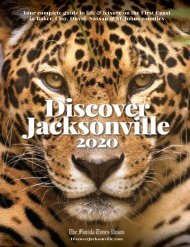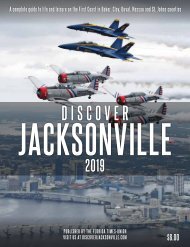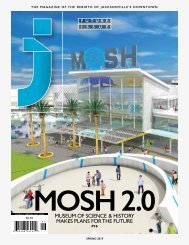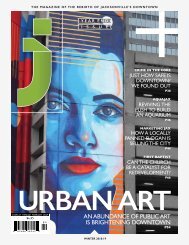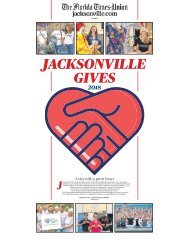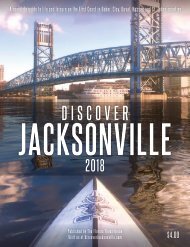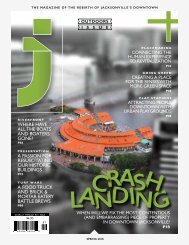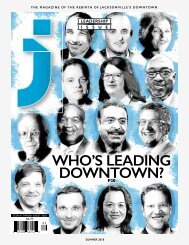J Magazine Winter 2019
You also want an ePaper? Increase the reach of your titles
YUMPU automatically turns print PDFs into web optimized ePapers that Google loves.
how kids are so hooked on playing these computer games. I had my<br />
entertainment every day and for an eight-hour period.<br />
“And again, being single, I worked a great deal of overtime. So I<br />
worked double shifts, and I worked at some of the busiest terminals in<br />
the New York City transit system.<br />
“It was a source of pride every day to move literally millions of people<br />
passing through your hands, so to speak.<br />
“From there, I was bitten by the bug. Every day you just strive to<br />
do better than you did the last day, and you had to make split-second<br />
decisions in terms of processing trains and passengers. And the next<br />
day, that orchestra, that symphony, started all over again.”<br />
Moving people’s lives<br />
In 1992, Ford took his ambition on the road. He became an assistant<br />
chief transportation officer for San Francisco Bay Area Rapid<br />
Transit, responsible for the commuter rail between that city and Fremont.<br />
The experience taught him not only another mode of transportation<br />
but also how to work with local governments and elected<br />
officials, as the route traversed multiple jurisdictions.<br />
After five years, Ford came south to be senior vice president of<br />
operations for the Metropolitan Atlanta Regional Transit Authority,<br />
ninth largest in the country, where he expanded his band width to<br />
multi-modal operations, with more than 680 buses serving 25 million<br />
miles and a rail system with 38 stations connecting 48 miles of track.<br />
He was named CEO in 2000, leading the rehabilitation of the system<br />
When Nat Ford was hired as CEO of JTA in 2012, one of his first challenges was to fix a decades-old bus route system.<br />
and implementing the first complete passenger-fare smart cards in<br />
the country.<br />
This experience was his second major inflection point, as Ford<br />
began to learn that public transportation is more than modes, tracks,<br />
bus stops and equipment.<br />
He says he was profoundly influenced<br />
by his board, which included Juanita Abernathy,<br />
widow of civil-rights icon Ralph David<br />
Abernathy; Joseph Lowery, another prominent<br />
civil rights leader, and other community leaders.<br />
“It’s shaped who I am today to a large degree in terms<br />
of my leadership attitude,” Ford said. “Up until that time, my whole<br />
focus was more performance-related terms of on-time performance,<br />
vehicles, really statistically kind of just the day-to-day blocking and<br />
tackling of making the trains run on time. They helped me truly understand<br />
the importance of transportation to the community, from<br />
an economic standpoint, from a health-care standpoint, from an equity<br />
standpoint, in terms of accessibility, to hospitals, to jobs, to college<br />
and educational opportunities.<br />
“So that kind of spirit that I have now in what I do here at the JTA,<br />
yeah, it’s buses. And yeah, it’s the Skyway and yeah, it’s road projects,<br />
but at the end of the day, what I really preach to our staff is what does<br />
it mean, in terms of somebody’s lifestyle and generational lifestyle,<br />
and access to economic vitality and health care.”<br />
Holism and technology<br />
Ford returned to the West Coast for his third inflection point. In<br />
2006, he became CEO of the San<br />
Francisco Municipal Transportation<br />
Agency and broadened his<br />
experience by being responsible<br />
for the city railway, parking and<br />
taxis.<br />
He led the integration of the<br />
siloed system.<br />
“The citizens actually chose to<br />
do that, because they did not like<br />
the disjointed decision-making<br />
around transportation. Transit<br />
was a No. 1 priority. But people<br />
walk, they bike, they actually park<br />
and they wanted a holistic strategy<br />
for the governance and objective,<br />
professional decision making<br />
on the balance between those different<br />
modes.”<br />
Even more important, Ford<br />
discovered that technology could<br />
make complex systems function<br />
faster, smoother and more efficiently.<br />
The San Francisco agency<br />
launched the nation’s first parking-management<br />
system, an app<br />
that provides real-time information<br />
about parking availability.<br />
“The idea was to cut down<br />
congestion in 48 square miles,” he<br />
said. “I have to get you in a parking spot as soon as possible. I don’t<br />
need you circling around looking for a parking spot on the street<br />
and quite often a lot of the municipal parking lots were empty. We<br />
developed an app that actually got you right to a parking spot, and<br />
if you chose, that app would also take you into a nearby municipal<br />
garage where the rates were actually lower. So we got into congestion<br />
22<br />
J MAGAZINE | WINTER <strong>2019</strong>



